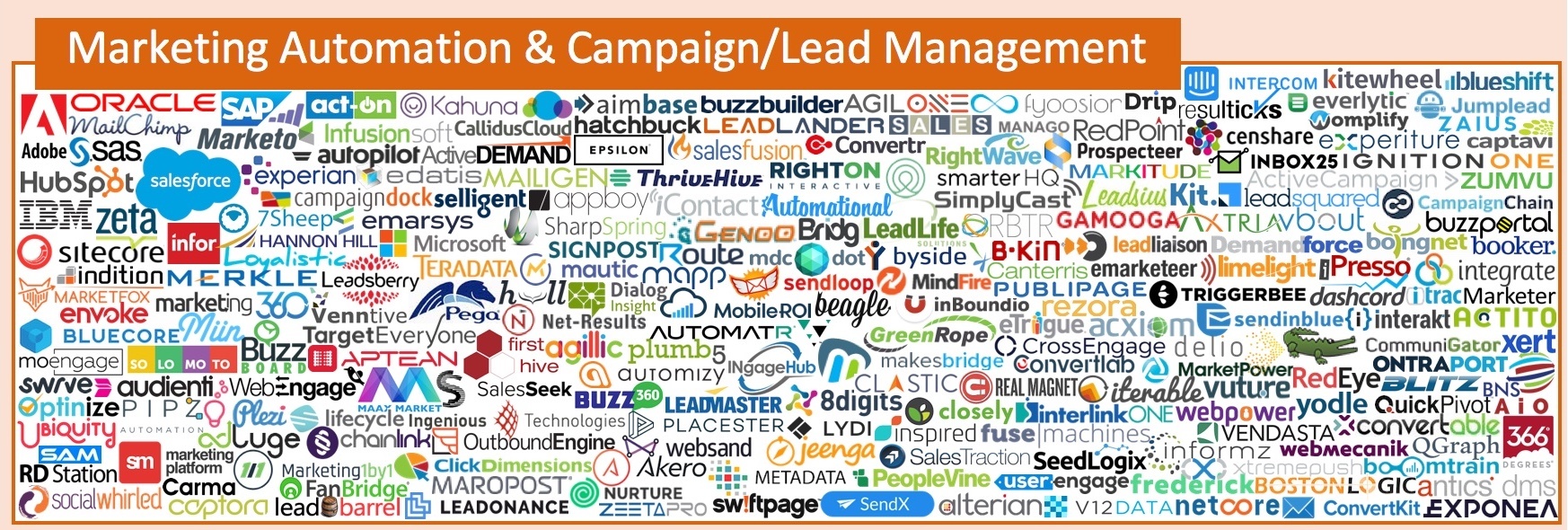Om du ska välja Marketing automation-system kanske du känner till nedanstående graf. Det är en bild på de nära 300 systemen som finns på marknaden idag:

Och antal system växer kraftigt för varje år. Men när man läser bloggar av några av de största systemleverantörerna kan man lätt tro att deras system har något alldeles unikt eller att de har uppfunnit själva kategorin Marketing automation.
Faktum är att alla populära system (t ex Hubspot, Pardot, Marketo) kopierar friskt av varandra. Vi har idag ett landskap av system som alla gör ungefär samma saker.
Funktioner när man väljer marketing automation-system
Eftersom alla system kopierar av varandra har idag nästan alla populära system följande funktioner:
- Inbound (landningssidor, email tracking, spårning)
- Synkmöjligheter (synka med eventverktyg, chatverktyg och CRM)
- Bra emailediterare (med drag-and-drop-möjligheter så ni kan skapa egna designs)
- Spårning och kontakthistorik (så ni kan se exakt allt era kontakter gjort)
- Kvalificering (poängsättning)
- Automationer (skapa kampanjer i flödesdiagram med händelser och förgreningar)
- Inbyggt CRM som är lätt att använda och anpassa
Hur valet av marketing automation blir fel
På grund av att alla populära system gör ungefär samma saker är det oftast inte fel systemval som leder till att man inte lyckas.
Jag har till och med sett företag byta från Hubspot till Pardot och tvärtom i tron om att det ska bli lättare att använda. Men eftersom båda har ungefär samma funktioner och fungerar på liknande sätt spelar bytet ingen roll.
För de flesta företag är det inte bristen på funktioner som är problemet. Utan komplexiteten. Och genom att ta nya features från varandra hela tiden blir de mer komplexa för varje år. Speciellt de lite större systemen som nu kommit till en punkt där de måste gå efter enterprise-marknaden för att behålla lönsamheten (ett väldigt vanligt fenomen i många brancher).
Ett marketing automation-system är i grunden en massa features ihopbuntade bakom en skärm. Det går att åstadkomma exakt samma sak genom att använda diverse gratisverktyg och bygga slottet själv.
 Fördelen när allt finns i ett system är så klart att allt är integrerat och fungerar tillsammans på ett smidigare sätt. Och data delas mellan olika komponenter. Men i grunden är ett Marketing automation-system en stor legolåda. En massa bitar som du måste bygga ihop själv.
Fördelen när allt finns i ett system är så klart att allt är integrerat och fungerar tillsammans på ett smidigare sätt. Och data delas mellan olika komponenter. Men i grunden är ett Marketing automation-system en stor legolåda. En massa bitar som du måste bygga ihop själv.
Och ju fler legobitar, desto svårare att bygga lego.
Det tar helt enkelt tid att implementera allt och få det att fungera ihop smidigt.
Så vad ska du tänka på när du väljer marketing automation-system?
Just på grund av komplexiteten, och på grund av att alla system är snarlika, blir systemvalet i sig sekundärt. Istället blir den support leverantören som du väljer att jobba med desto viktigare.
Och i valet av leverantör bör ni titta efter tre varningsklockor:
- Om leverantören försöker binda upp er på långa kontrakt
- Om de tar höga startavgifter, utbildningsavgifter, workshopavgifter eller höga avgifter för att implementera (detta visar bara på att systemet är komplext)
- Och om deras affärsmodell verkligen ger dem incitament att fortsätta hjälpa er efter att bindningstiden är slut.
En affärsmodell som bygger på att leverantören (eller, i många fall, byrån som säljer systemet lokalt) får stora pengar vid uppstart och har långa bindningstider visar att de inte räknar med en lång relation.
Välj istället en byrå eller systemleverantör som inte har bindningstider, låga startavgifter, och där de tjänar pengar endast om ni stannar med dem i det långa loppet. I slutändan tjänar både ni och den leverantören mer på det.
Vill du testa att bli marknadsförd till?

Vill du se hur det känns att bli marknadsförd till med ett Marketing automation-system? Testa vårt automatiska flöde med ett email i veckan i 5 veckor där varje mail med videos, screenshots och roliga övningar visar hur systemet reagerar interaktivt på dina handlingar.

